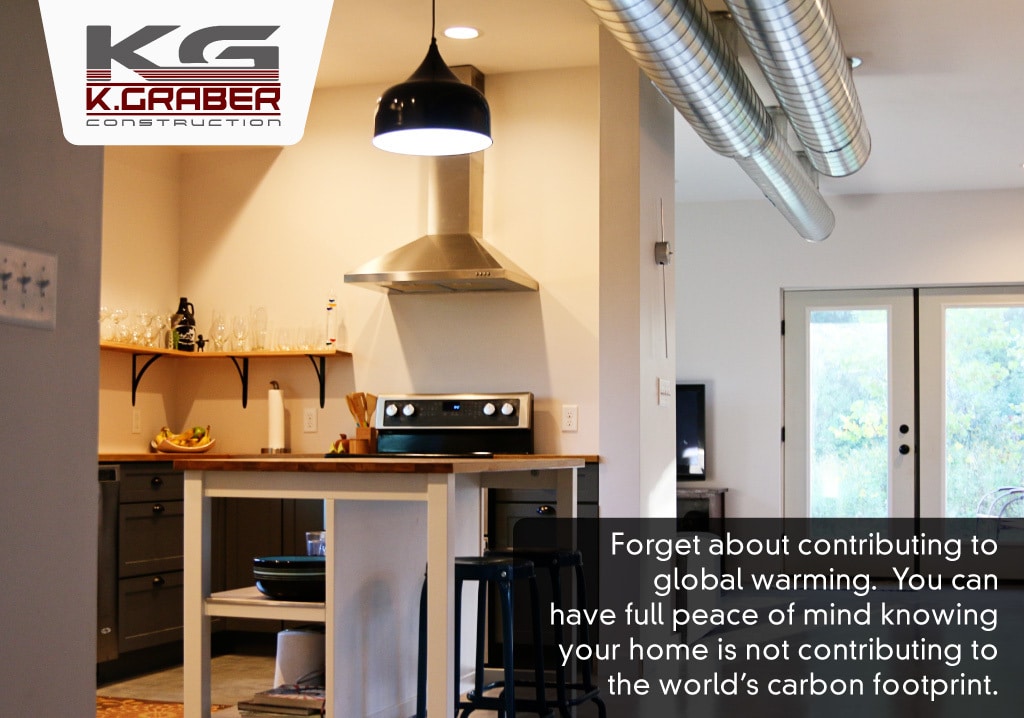
Net Zero Homes & New Energy Homes – The Benefits And Differences
Like many homeowners, you do your best to recycle, be energy efficient, and reduce carbon emissions, keeping the environment healthy for future generations.
But one of the most important times to think about energy efficiency is if you're building a new house!
At K Graber Construction, we want to help you build a new home that helps you contribute to a greener world and saves you money by reducing or eliminating energy bills.
In this article, we look at the benefits and differences between a new energy home and a net zero home. We also look at some of the challenges in reaching a home that is truly energy-independent.
Alright, let’s dig in!
What Is A New Energy Home?
A new energy home is a home designed to use 50% or less energy than a typical American home.
In 2018, the average American home used 10,972 kWh per year (this doesn’t include heating gas or oil). In the past 20 years, it is calculated that American homes were responsible for over 20% of U.S. carbon emissions.
What do these numbers tell us?
They show that the average American home has a long way to go toward being cleaner and more sustainable. It also shows that homes play a large role in the energy usage and carbon emissions of the United States.
Imagine if all American homes were new energy homes by next year. That would reduce the overall United States energy consumption by over 10%!
Benefits Of A New Energy Home
Having a new energy home is the first step in creating a home that is truly energy efficient. Let’s take a look at some of the benefits of having an energy-efficient home.
Eco-friendly
Reducing carbon emissions is important, whether it's electricity, heating oil, propane, natural gas, or some other energy form. New energy homes’ commitment to reducing energy by 50% makes them eco-friendly.
Sustainable
Not only are new energy homes eco-friendly, but they are also more sustainable than traditionally-constructed homes.
Because of the focus on energy savings and efficient designs, building materials used in new energy homes are typically greener and made with more sustainable methods than normal home building supplies.
Low Carbon Footprint
The less energy you need for your home, the lower your carbon emissions and footprint will be!
Grid Efficiency
When you use less energy to power your home or business, especially during peak hours of the day (usually late afternoon and early evening), your local power grid becomes more stable.
Energy Savings
New energy homes focus on making homes eco-friendly, but this comes with a financial benefit too: Lower utility and energy bills.
And while it is true that a new energy home may cost more to build initially, over time you will see that value returned in your monthly budget as you save on your heating, cooling, and electric bills.
Also, depending on your state and the materials you use, you may be eligible for government rebates or tax credits for using energy-efficient building materials.
(Want to find small ways to save on energy costs? Consider installing a stone-coated metal roof.)

Increased Home Value
Along with the energy savings, you'll also save money in the long run because your home will increase in value. Buyers are quicker to purchase a home or pay a higher price if they know the home is energy-efficient, eco-friendly, and has lower energy bills.

Ways To Design A New Energy Home
To achieve the required 50% or more drop in energy usage, designers and contractors have to be very specific in the way they design and build new energy homes.
The main goal is to control the temperature and heat transfer. The more a home transfers heat, either into or out of the home, the less efficient it is.
The goal in the summer is to keep the warm outside air from coming into the home. In the winter, the opposite is true—the cold air needs to stay outside.
So how do builders eliminate this heat transfer and build a new energy home?
Keep reading to find out!
Hybrid Insulation
Insulation is one of the most critical elements in maintaining a consistent home temperature. New energy homes use a hybrid insulation package to maximize energy efficiency while minimizing heat loss.

Building Materials
To reduce energy usage, it's important to choose the right materials. For your new home, choose windows, doors, siding, and other construction materials that live up to peak efficiency standards.
Structural Design
Although materials play a large part in saving energy, the structural design also plays a critical role. New energy homes focus on creating efficiently-designed foundations, basements, and wall cavities.
Energy Star Appliances
Another important energy-saving step is choosing energy-efficient appliances. While it's not as critical as controlling temperature and heat transfer, appliances still play a role in a home’s energy savings.
No matter how you go about building a new energy home, you'll need an expert to help you get there. That's why hiring a good contractor is so important!
(Confused about how to find a good contractor? Read our blog post on 9 tips for hiring a contractor.)
What Is A Net-Zero Home?
Now that we have discussed new energy homes, let’s take a look at net zero homes.
Net zero homes take the new energy home concept to the next level by reaching a net energy usage of zero.
That's right. Zero, as in, nothing.
How is this possible?
Through extreme energy efficiency, reduced heat transfer, and energy creation on the property, a net zero home is able to eliminate its carbon footprint!
But it gets even better than that:
Net zero homes use solar power or wind power generated on their property, which means they can inject power back into the grid. This power injection means that a net zero home is not just carbon neutral, but carbon negative!

Benefits Of A Net Zero Home
The largest benefit by far of a net zero home is the fact that it is carbon neutral or carbon negative. Even though it might be a single home in a neighborhood, it still has a tremendous impact on the environment and the local utility grid!
Many of the benefits are similar to new energy homes, but they come with greater benefits.
Let’s take a look.
Zero Carbon Footprint
Forget about contributing to climate change. You can have full peace of mind knowing your home is not contributing to the world’s carbon footprint.
Instead, there is a good possibility that you are helping to reduce the overall carbon footprint!

Eco-friendly
No modern living solution is more eco-friendly than a building with a net zero carbon footprint. And if you are adding energy to the grid and becoming carbon-negative, even better!
Sustainable
Net Zero Homes take sustainability to the next level. Not only is the home energy independent, but the construction materials are often also LCCA (Life Cycle Cost Analysis) efficient.
LCCA efficient means the building products are also sustainable and produced in eco-friendly and efficient ways. So not only is your home efficient, but the building materials were also manufactured efficiently!
Grid Efficiency
When you have a home solar or wind generator, you will sometimes have more energy than you need and can sell some of that power back to the grid, which makes the overall grid more stable and efficient.
Energy Savings
Although net-zero homes have a higher initial cost, the energy savings over a home’s lifetime are huge. Many homeowners find they pay off the difference sooner than they thought.
The amount you can plan to save on energy depends on your area’s energy prices, but as utility costs continue to rise, you will see an even more significant payback.
Plus, solar and wind generation currently has tax incentives from the federal government, and many states also provide financial incentives for installing solar or wind.
Also, if you produce more power than you use, some states require the utility company to write you a check for your kWh production!
Increased Home Value
When the time comes to sell your home, not only are you selling a home with no carbon footprint, but it also comes with no utility bill.
There is no doubt about it—having a home with no utility bill is a big seller!

Ways To Design A Net-Zero Home
Achieving a net zero home begins the same way as a new energy home: the designer and contractor need to take special care in the building materials, methods, and appliances used on your home.
However, the materials and construction methods only get you halfway there.
To eliminate the other 50%, you need to install something that actually generates power. A diesel or propane home generator doesn't count—you need solar panels or wind turbines.

Challenges In Reaching A Net-Zero Home
Carbon-neutral and carbon-negative homes are becoming more and more attainable, especially since so many energy-efficient appliances are entering the market.
However, while net zero homes are awesome and have a much better overall impact on the environment, they do come with some challenges.
They Cost More Than A Traditional Home
Although net zero homes are a good financial decision overall since the costs are eventually offset by energy savings, they still cost more money upfront, which can be a significant burden depending on the circumstances.
They Still Need To Be Connected To A Utility Grid
While it is easy to dream about living completely off-grid, that's just not a reality for most net zero homes.
Because solar and wind power fluctuates based on the weather and time of day, your home still needs to be connected to the utility grid, or else you won't be able to run any appliances on windless nights.
If you want to be truly off-grid, you'll need to install a battery pack or AC generator. While this is great for wilderness areas, if you have the opportunity to connect to the grid, you'll save money long-term by doing so.
However, as solar, wind, and battery technology continues increasing and being refined, going completely off-grid becomes more and more attainable!

K. Graber Construction Can Help You With New Energy And Net Zero Homes
At K. Graber Construction, we work hard to help homeowners in North-central Indiana be green, sustainable, and energy-conscious.
To help with this mission, we build custom new energy and net zero homes for our valued clients.
Besides new home construction, we also offer:
If you are interested in the peace of mind and efficiency of a custom new energy or net zero home in Indiana, then contact the K. Graber team today!

